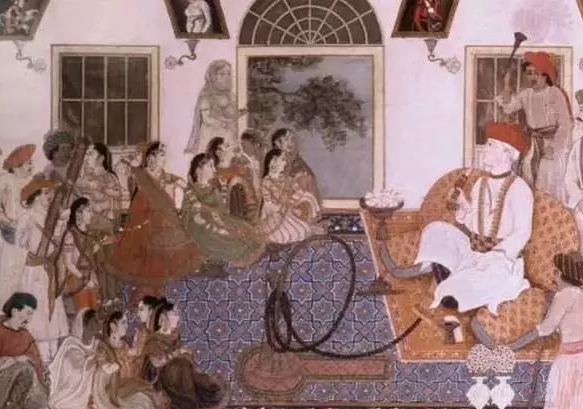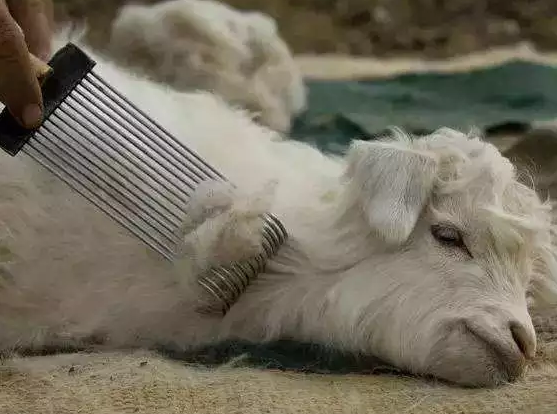As a belligerent race, humans will fight for various reasons because of women, because of the ball game, because of their responsibilities to the allies, or because of the territory. But there are also wars that arise because of the fine hair. This hair is produced on goats in cold regions and is only a dozen microns thick. Click to learn immediately about the brand of cashmere sweater In order to fight for this group of goats to protect the cold, the soldiers armed with mauser guns, shields, swords, and small artillery have met each other in the extremely cold plateau of more than 4,000 meters and killed each other. Click to learn immediately about the brand of cashmere sweater A cashmere journey Click to learn immediately about the brand of cashmere sweater Every link has a clear responsibility to ensure that the final consumer is a fully qualified product. According to Zhang Zhi, “Everything in Ordos is traceable. For example, this cashmere sweater has a problem. I can trace back to which batch of raw materials to use, and this material is the area from which it is combed. After all, I don't know what's going on. I can't prevent it next time. It's very important." Gunfire War Road July 2011, Tibet Ali area, the Japanese cashmere goats original farm. White cashmere goat is the most important economic source in the area Click to learn immediately about the brand of cashmere sweater Incompetent times of chaos Click to learn immediately about the brand of cashmere sweater Challenge the Rise of the International Order Unwilling Erdos intended to fight back and change this unequal situation. “Wang always said that first-class companies do standards, second-rate companies engage in brands, and third-rate enterprises do products.†Zhang Zhi said, Wang Linxiang gave her a big topic, asking her to bring in the world’s best cashmere researcher. Come to Ordos to find out about the status of Chinese wool and the issues of communication standards. It's not so easy to do the standard. Ordos Cashmere Industry Group found that the detection method of cashmere pilling in the world is very confusing. Zhang Zhi led the team to decide to start a standard that is most suitable for the detection of cashmere pilling. Click to learn immediately about the brand of cashmere sweater Want to learn more about cashmere sweater: accessible Pay attention to WeChat public number "Cashmere sweater industry platform" to learn more about cashmere sweater information Man'S Chino Shorts,Mens Chino Summer Shorts,Men Gym Jogger Short,Men'S Multi-Color Casual Shorts Shaoxing Tongbang Textile Co.,Ltd. , https://www.sxtongbangtextile.com
In the 17th and 19th centuries, such wars took place from time to time. People died in the war, the regime changed after the war, and the layer of fluff that grew on the goats had always existed. It grows continuously and continues to fall off. As a result, there will always be new wars.
In the era when mankind became more civilized, Zhang Zhi, Chief Engineer of Ordos Cashmere Group Co., Ltd. had seen other wars that have continued to unfold during the past decades. She also participates in it and is mentally exhausted. This war is very different from the purpose of a hundred years ago. The original politicians used steel guns to promote trade, and now entrepreneurs are hoping to establish a new order, so that consumers in the market can better understand cashmere and avoid the traps one after another.
Every May and June at the turn of the spring and summer, the fluff on the goat's body became fluffy. Herders in Ordos knew that the time had come.
In good weather, the herdsmen were satisfied with food, taking ropes, scissors, and scorpions, and went to the sheep pen. They seized the sheep’s hindquarters and tossed them hard. They tossed them and tied the three legs together with ropes. In the anxiety of the goats, they cut off the long hairs of the goats and laid them against the bottom of the skin. It revealed.
The nephew is then sent to use it as a tool made of steel wire, like a rake. The herders held the crickets in one hand, grabbed the leg of the unglawed one in one hand, and took down the soft fluff. Grab one side, one leg up, turn over and grab the other side.
Zhang Zhi has seen countless times and has been very familiar with this process. For cashmere, the long journey has only just begun.
"The recovered cashmere is hand-tamed. Zhang Zhi said that because of the different parts of the goat, the quality of the cashmere is also different and the machine cannot distinguish between them. "The velvet on the back is a little better, the velvet on the legs is a bit smaller, and the velvet is separated. Good, good, bad, only manual sorting, there is no other way. "There are some variegated hair, but also to separate.
After the completion of the division, the soil will be hit, and the feces, hybrid branches, and straw that are doped therein will be destroyed. Wash and dry again, followed by another selection. “The raw materials are dirty, and the different colored hairs are not clearly seen. If there is noise after washing, it is obvious.†There are fewer companies that insist on doing this process, but Erdos Cashmere Group is still doing it. Once the finished product is found, variegated velvet is found, and picking one by one is very troublesome, so we would prefer to add a check before it. If quality requirements are not high, there are a few black hairs that don't matter.
After the election, it is still a combination of wool and cashmere, and it requires a carding procedure to separate wool and wool. Reprocessing, spinning, and making finished products. "I'm talking about a big process." Zhang Zhi said that the middle process is more complicated. From the fluff of goats to the cashmere products such as Ordos cashmere sweaters and scarves purchased by consumers, there are more than 120 processes in each step. Every step in the process, Ordos Cashmere Group has a quality inspection link. 
This aspect is to be able to better correct the problems encountered, and more importantly, it is also the responsibility of consumers. “I took a small example casually. When a cashmere sweater is sewn, it should be placed on a lamp to see whether it has a leaked seam, whether it has a needle dropped, or if there is any defect in the weaving process, check it. A small loophole, for the consumer, the clothes he bought are unqualified.†Such a thing cannot be done.
China is the world's leading producer of cashmere. According to statistics, 70% of the world's cashmere is produced in China, but the use of cashmere is not popular from China. “The use of cashmere actually started from the European court aristocracy, like Napoleon,†Peng Yanli, deputy secretary-general of the China Textile Industry Federation, said in an interview with this reporter.
Shawls should flow from the Himalayas. In the Himalayan region of the 18th century, the situation was complicated. A series of political forces in Tibet, such as the local regime, Dalak, Kashmir, Mogul Empire, and Afghanistan, have seen a shift in this region. In the mountains and mountains where these regimes are located, there exists a “cashmere roadâ€. Cashmere produced in China and Central Asia passes through Tibet, passes through rapids and pass through mountains, and arrives in Daraq, where they are re-exported to Kashmir. Shawls, sold to Europe and the United States. 
Every regime hopes to firmly hold the cash flow of cashmere trade in its own hands. In the era of scarcity of cashmere products, it does not matter who will buy Kashmir shawls. What is important is the huge profits attached to cashmere.
The Mogul Empire was the first to control the entire cashmere road through three battles. But then, the forces of the British East India Company entered the region and gradually replaced the influence of the Moghuls. The ambitious Sikh Prime Minister, Gurabo Singh, conquered Kashmir with the disintegration of the Moghul Empire. However, Singh soon discovered that the traditional trade order has been broken by the British, and cashmere has flowed to the British and Indian territories, sharing the market share of cashmere. He decided to continue the war, control Tibet, and restore the cashmere trade channel that was disrupted by Britain.
On December 12, 1841, the prepared Chinese and Sikh soldiers met at an altitude of 4572 meters. Then, the two sides launched a fierce battle. The winter in the plateau was extremely cold, with strong winds and shaved faces. The soldiers on both sides were not warm with cashmere shawls, so they ran up against the cold air, screaming and smashing, gunshots and wounding of the wounded in the snow. The plateau rings. There have been many such battles, but both sides have no hope of winning. Peace talks have become the best ending. According to the treaty, the traditional boundary line was confirmed and the dignity of the Qing Empire was maintained. At the same time, Singh also controlled the cashmere trade in this area in disguised form. For the arrogant Qing court, the business in the western outlying areas is not so important.
The British obviously do not think so. This treaty broke the British attempt to monopolize the cashmere trade. In 1845, Britain took advantage of the political turmoil in Sikh and launched the first Indo-Switzerland war. It opened the doors of Sikh with light artillery. Singer betrayed his own king, entered into a treaty with Britain, established Kashmir as a free state and became a British affiliate. As a result, the cashmere war between Singh and Britain ended, and Britain inherited Sikh's control of cashmere.
When the countries of Central Asia and the United Kingdom fought a war on the cashmere trade, the Chinese government did not pay sufficient attention to this precious resource, mainly because of technical problems.
“China had a wool spinning industry in the late Qing Dynasty, but the cashmere processing industry did not appear until the late 1960s (in the 20th century) in China,†explains Peng Yanli, deputy secretary-general of the China Textile Industry Federation. “At the end of the 1960s, China developed the first generation of cashmere carding equipment. Previously, this equipment was only manufactured in countries such as the United Kingdom.â€
At that time, cashmere exports were all uniformly priced and sold in unison. Peng Yanli said, “In 1985, the state liberalized the operation of cashmere and entered the free market era.†However, in the early period of opening up, there was no competitive and orderly cashmere raw material market. High profit drive, a large number of speculative people to do cashmere business. This has caused confusion in the market, followed by a lot of adulteration, and the quality of raw materials has dropped.
The 1988 cashmere war was staged in this context. Zhang Zhi has so far been impressed by the war. The price of cashmere has risen with the release of government regulations, "up to a maximum of one ton of plush down to 1.2 million." Zhang Zhi said, “The more people who get adulterated, the more farmers and herdsmen add sand, add salt, and add heavy metals...the original velvet is very light. Take a handful, heavy.â€
The whole market was messed up. The quality has fallen sharply, and the prices have also fallen. Zhang Zhi recalled that “the export price of China's plush was quickly reduced from 1.2 million to more than 300,000.â€
It was during this period that Zhang Zhi’s Yi Meng cashmere sweater factory changed its name to Ordos cashmere sweater factory, and began the transformation and expansion pace. “At that time, Wang Zong (Chairman of the Board of Directors of Ordos Investment Holding Group Wang Linxiang) said that cashmere is worth more than 300,000 yuan, or a large number of acquisitions, and after adding value, it is certainly not only this value. After the purchase, it went up again in 1991 and 1992. 90 million, we have piled up a lot of cashmere, more than 300,000 to buy, rose to 900,000, the benefits will come up all at once, the role of business decision-making in this process is very important."
The recovery of prices is closely related to the government's rectification. According to Peng Yanli, in 1991, relevant Chinese authorities started export license management for export disorder, and set a minimum export price. Peng Yanli said: “Before 1995, the public auction method was adopted, and the auction was hairless that year. Cashmere permits. After taking these measures, the export of cashmere has gradually stabilized."
In 1812, a veterinarian of the East India Company, Molkrov, “under the call of the British Empire to obtain the best wool fibers†went to Tibet to inspect and purchase 25 pairs of Tibetan goats, ready to transport them home. Only eventually died. After more than a hundred years, this effort has continued. According to the "CPPCC Economic Forum," from 1966 to 1967, India, Australia, and other countries blew up the frontier of the Chinese Cultural Revolution and stole nearly 10,000 heads of Chinese excellent cashmere goats from the border of Tibet.
There is a reason for the strong demand abroad for Chinese goats. "China's cashmere quality is the best," Zhang Zhi said. "Especially from the Inner Mongolian weft line, from Ningxia and Gansu to Xinjiang, the cashmere produced is thin and long. When going north, the cashmere becomes thicker. Now, going south will be shorter."
The fineness of cashmere specified in the American Wool Product Labeling Act is 19 microns or less, but the average fineness of the Ordos Group for cashmere is strictly controlled below 16 microns. Zhang Zhi said that in terms of standards for production, the Chinese cashmere standard is also higher than international standards.
However, China's high-quality cashmere has never had the right to speak in the international market, because the standards and testing methods for cashmere are set by Britain and other Western countries. This will affect both the competition with other countries' cashmere and the price.
“Before the reform and opening up, foreigners were able to buy us a pound of cashmere for a few boxes of match money, but after a few foreign countries arranged it into lintless, they actually sold hundreds of thousands of dollars a ton. As a Chinese, Don't you feel bad?†said Wang Linxiang, chairman of the board of directors of Ordos Investment Holding Group. “Cashmere is a national treasure of China. We have been exporting for a very low price for many years. Foreigners have made big money and become famous. Even today, many foreigners even The Chinese also believe that the best cashmere products are produced in England, Scotland, Italy, etc. In fact, these countries produce very little cashmere." 
Great resistance. “At that time, Australia was still a bit despised by the Chinese people. It was always felt that the Chinese people were doing relatively blunt things and said that this is a very arduous task and it will not be completed for many, many years.†Zhang Zhi said, in fact, Australians are worried that this standard will affect them. The exit. Moreover, to internationally recognize this standard, it is necessary to do circular experiments - a dozen or so standard laboratories in the world can do it once according to this standard.
The data returned by the loop experiment was poor and failed. They looked for the cause and found that the box where the experiment was performed was not produced in one place and there was an error in the experiment. So the company allocated funds to make a uniform box. After doing another experiment, we found that the specifications of the hoses used for friction were also different. We also modified... After each experiment, experts will be organized to discuss issues, find problems, and modify experimental methods. After the round-by-round cycle experiments were completed, it was already 2011 when the "Cashmere, Wool Knitwear Pill Test Method" was finally released. This effort to regain the right to speak in the international market took a full 10 years. These efforts have not only won more rights for China's cashmere, but the Ordos Group has also been respected by international cashmere organizations and has become one of the few representatives of Chinese companies.
Now, Ordos Group is the only Chinese company member of CCMI (International Cashmere Camel Manufacturers Association). CCMI is one of the most influential organizations in the international cashmere industry. Hermès and Lauropia are its members. "It was they who invited us to participate," said Zhang Zhi. "Their president is very familiar with us and said that if China wants to join this organization, the first must be Ordos. He knows the influence of Ordos in China, so he wrote to President Wang, invite us to participate."
According to the data provided by Ordos Cashmere Industry Group, as of the end of 2014, the International Standards presided over by the Group's Technology Center completed one, two items are being formulated, two items are to be declared, 14 national and industrial standards, and 39 corporate standards. It has applied for 228 national patents, including 9 invention patents with independent intellectual property rights and 9 utility model patents.
With the standard, on the one hand, the order of competition can be more standardized, and at the same time, consumers can see this market more clearly. “Like diamonds, broken diamonds are not worth the money. A diamond of a few carats is worth the price. The existence of the standard is to let consumers understand what level of goods they buy.†Zhang Zhi said, “This is to Give consumers a clear explanation." 
Summary: